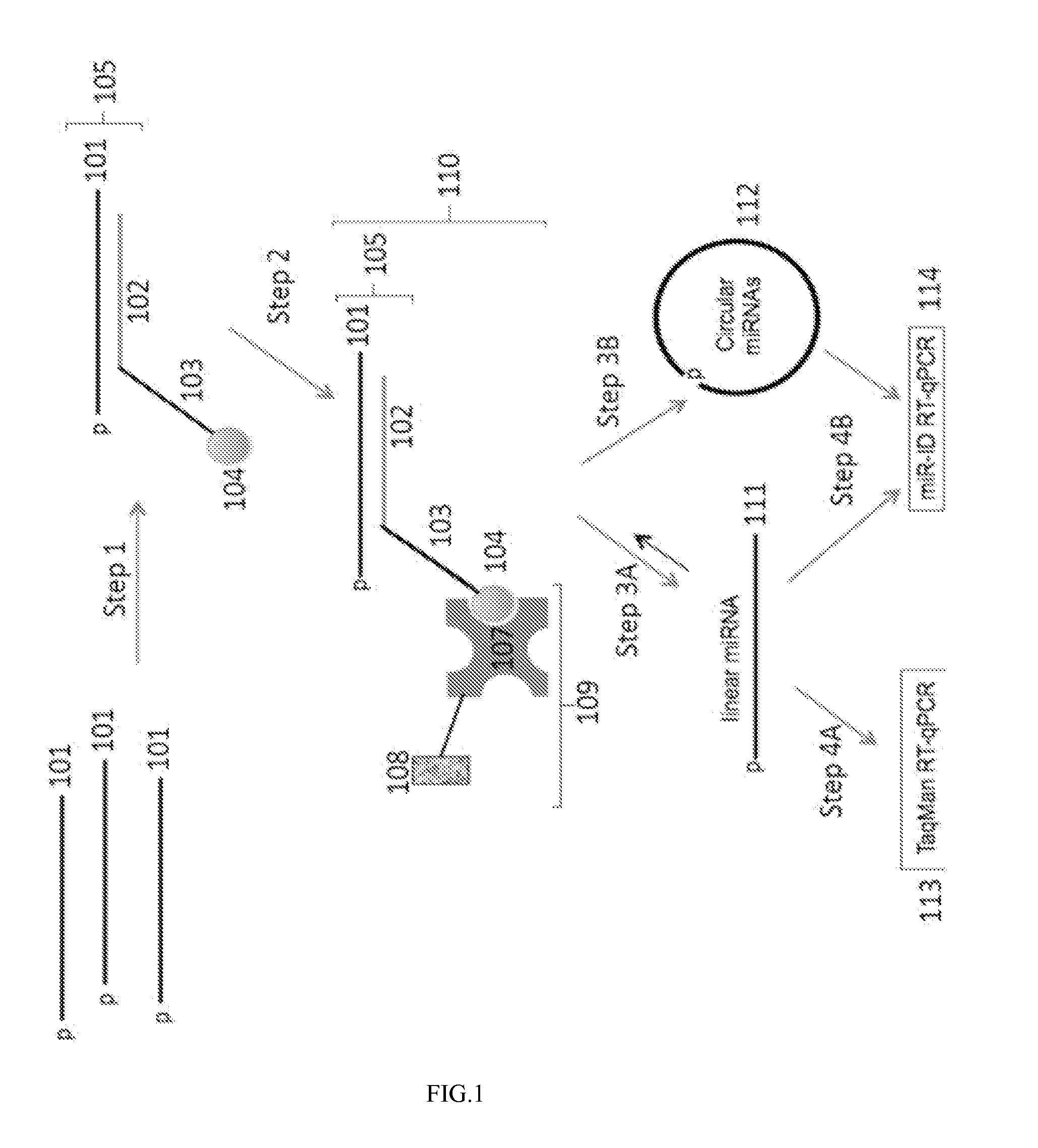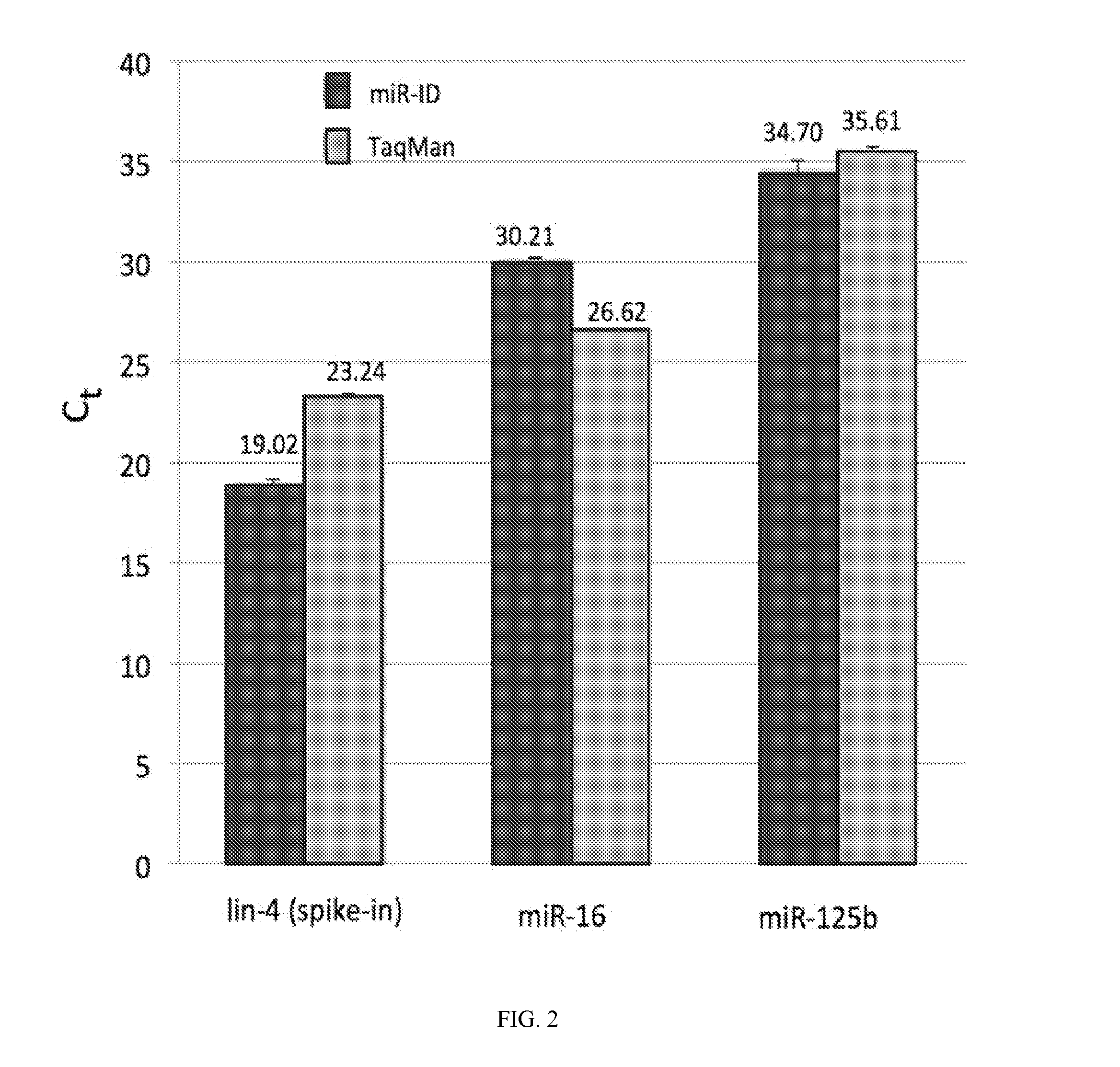Methods, compositions and systems for the analysis of nucleic acid molecules
a nucleic acid and composition technology, applied in the field of molecular diagnostics, can solve the problems of reducing the sensitivity and substantial sample-to-sample variability in both absolute and relative mirna levels, affecting the detection accuracy of rt-pcr inhibitors, and reducing so as to reduce or eliminate the loss of small rna, reduce the number of steps for preparation, and minimize the variability of rna recovery
- Summary
- Abstract
- Description
- Claims
- Application Information
AI Technical Summary
Benefits of technology
Problems solved by technology
Method used
Image
Examples
example 1
Direct Quantification of miRNAs in Plasma without Capture Using TaqMan or miR-ID Detection
[0210]Frozen plasma specimens obtained from Biological Specialty Co. were thawed and filtered through a 1.2-mm filter to remove cells and cellular debris as recommended by Bryant et al. (2012). 24 μl of plasma was mixed with 1 μl of an RNAse inhibitor and incubated at 60° C. for 10 min. Next, an equal volume (25 μl) of a release / dissociation buffer and 1 fmol of synthetic lin-4 miRNA (as a spike-in control) was added and incubated at 25° C. for 1 hour. The samples were subsequently heated at 95° C. for 5 min and then centrifuged at 16,000 g for 4 min at 25° C. The supernatant was collected and 4 μl aliquots (each corresponding to 2 μl of the original plasma) were analyzed by miR-ID (Kumar et al. 2011) and TaqMan (Chen et al. 2005) RT-qPCR assays specific for hsa-miR-16-5p (miR-16), hsa-miR-125b-5p (miR-125b), cel-lin-4 (lin-4) and cel-miR-39 (cel-39) shown in Table 1. The results are shown in F...
example 2
Quantification of miRNAs in Different Volumes of Plasma by miR-Direct using miR-ID Detection
[0214]Various volumes (25, 100 or 400 μl) of plasma sample #55, which was collected in an EDTA-containing tube from one individual, or 200 μL of plasma sample #M7259 collected either in heparin- or EDTA-containing tubes from a second individual (provided Biological Specialty Co.) were treated as follows to release the circulating miRNAs into solution. An equal volume of a lysis buffer was added to each plasma sample. Then a carrier RNA and 1 fmol cel-39 spike-in miRNA were added sequentially. The entire mixture was incubated at 25° C. for 1 hour. Following this incubation, 16 pmol of each of a set of target-specific oligonucleotide probes (TSPs) biotinylated at their 3′ ends (3-BioTEG, IDT), which were specific for miRNAs present in human blood (miR-16, miR-125b, miR-148a, let-7d, let-7g, miR-15b, miR106a, miRl42, miR-191 and miR-301a) or spiked-in miRNA cel-miR-39 (cel-39) (Table 3) were add...
example 3
Quantification of miRNAs in Various Plasma Samples by miR-Direct using miR-ID Detection
[0218]400 μl of each of plasma sample from 11 healthy donors were analyzed using the miR-Direct capture with miR-ID detection specific for the circulating miRNAs hsa-miR-16, hsa-miR-125b and hsa-miR-148a as well as a spike-in control, cel-miR-39 as described in Example 2.
[0219]In this example, we observed that the levels of the circulating miRNAs varied by 1-3 Ct units among the various plasma samples while the spike-in control remained constant (FIG. 4). To verify the Ct variations measured by miR-Direct, we compared the results obtained by miR-Direct and conventional miR-ID, which uses column-purified total RNA (see Example 4 and FIG. 5).
PUM
| Property | Measurement | Unit |
|---|---|---|
| temperature | aaaaa | aaaaa |
| temperature | aaaaa | aaaaa |
| temperature | aaaaa | aaaaa |
Abstract
Description
Claims
Application Information
 Login to View More
Login to View More - R&D
- Intellectual Property
- Life Sciences
- Materials
- Tech Scout
- Unparalleled Data Quality
- Higher Quality Content
- 60% Fewer Hallucinations
Browse by: Latest US Patents, China's latest patents, Technical Efficacy Thesaurus, Application Domain, Technology Topic, Popular Technical Reports.
© 2025 PatSnap. All rights reserved.Legal|Privacy policy|Modern Slavery Act Transparency Statement|Sitemap|About US| Contact US: help@patsnap.com



